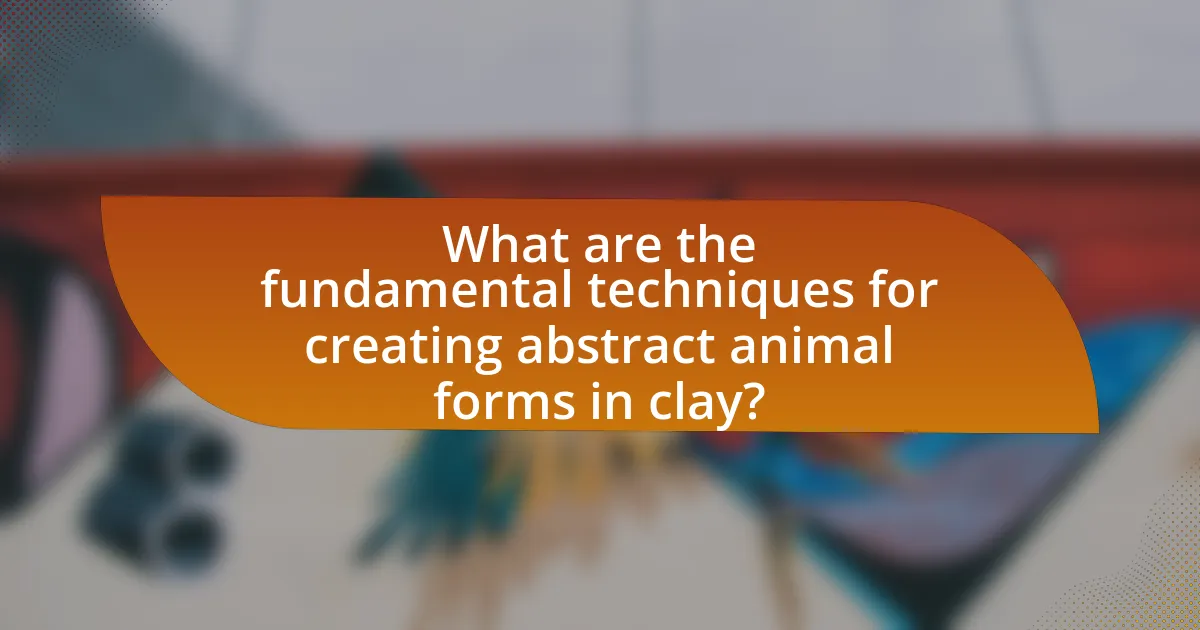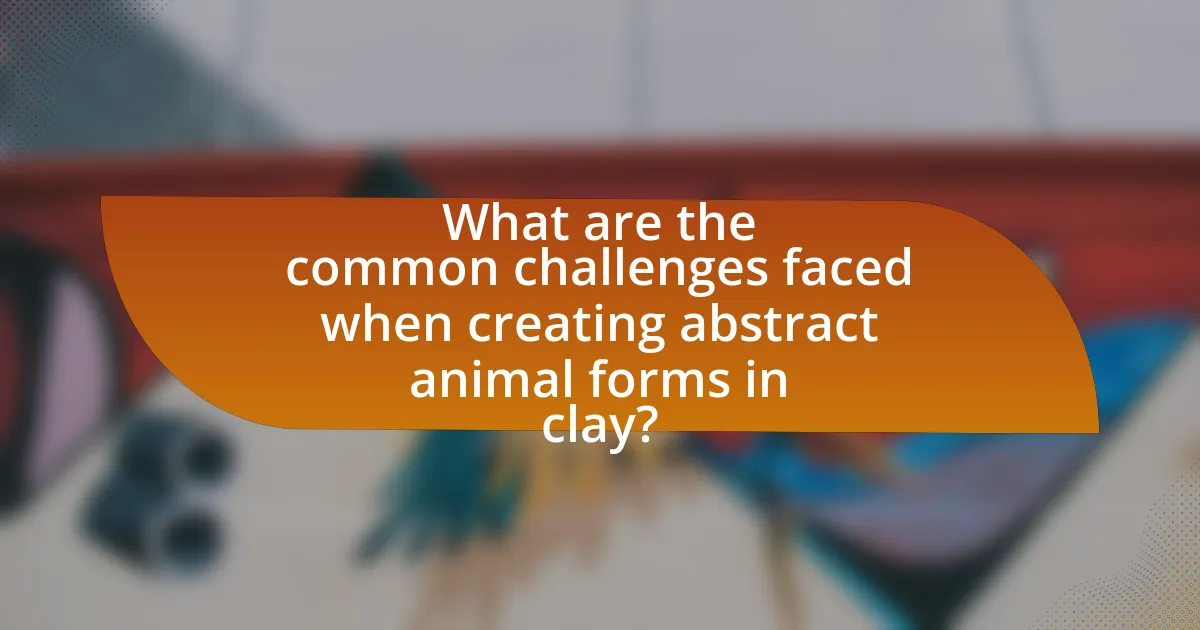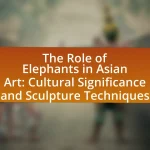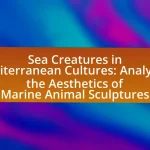The article focuses on techniques for creating abstract animal forms in clay, detailing fundamental methods such as hand-building, sculpting, and texturing. It explores how different clay types influence the sculpting process, highlighting characteristics of earthenware, stoneware, porcelain, and polymer clays. The article also addresses the impact of moisture content, essential tools for sculpting, and strategies for achieving abstraction through simplification and stylization. Additionally, it discusses common challenges faced during the sculpting process, including cracking and warping, and offers best practices for finishing and firing sculptures to enhance their final appearance.

What are the fundamental techniques for creating abstract animal forms in clay?
The fundamental techniques for creating abstract animal forms in clay include hand-building, sculpting, and texturing. Hand-building involves shaping clay using techniques such as pinch, coil, or slab methods, allowing for organic forms that can represent animals abstractly. Sculpting focuses on manipulating the clay with tools to refine shapes and add details, which can enhance the abstract representation of animal features. Texturing adds depth and interest to the surface, using tools or natural materials to create patterns that suggest fur, scales, or feathers, contributing to the overall abstraction of the animal form. These techniques are widely used in ceramic art, as evidenced by numerous art schools and workshops that emphasize their importance in developing unique artistic expressions.
How do different clay types influence the creation of abstract animal forms?
Different clay types significantly influence the creation of abstract animal forms by affecting texture, malleability, and firing characteristics. For instance, earthenware clay is more porous and easier to manipulate, allowing for intricate details in abstract designs, while stoneware clay offers durability and a smoother finish, which can enhance the overall aesthetic of the form. Additionally, porcelain clay, known for its fine texture and translucency, allows artists to create delicate and refined abstract representations of animals. The choice of clay type directly impacts the artist’s ability to express their vision, as each type has unique properties that can either facilitate or limit the creative process.
What are the characteristics of various clay types suitable for sculpting?
Various clay types suitable for sculpting exhibit distinct characteristics that influence their usability and results. For instance, earthenware clay is known for its plasticity and ease of manipulation, making it ideal for beginners and detailed work. Stoneware clay, on the other hand, is durable and can withstand high firing temperatures, which is beneficial for creating robust sculptures. Porcelain clay is characterized by its fine texture and translucency, allowing for intricate designs but requiring more skill to handle due to its less forgiving nature. Additionally, polymer clay offers versatility and can be cured at low temperatures, making it suitable for detailed and colorful abstract forms. Each type of clay serves specific artistic needs, with properties that cater to different sculpting techniques and desired outcomes.
How does moisture content affect the sculpting process?
Moisture content significantly influences the sculpting process by affecting the malleability and workability of clay. When clay has optimal moisture, it remains pliable, allowing for easier shaping and detailing, which is crucial for creating abstract animal forms. Conversely, insufficient moisture leads to brittleness, making the clay difficult to manipulate and prone to cracking, while excessive moisture can result in slumping and loss of form. Studies indicate that maintaining a balanced moisture level is essential for achieving desired textures and structural integrity in sculptural works.
What tools are essential for sculpting abstract animal forms in clay?
Essential tools for sculpting abstract animal forms in clay include sculpting tools, wire tools, and modeling tools. Sculpting tools, such as loop tools and ribbon tools, allow for precise shaping and detailing of the clay. Wire tools are effective for cutting and slicing through clay, enabling the artist to create clean lines and forms. Modeling tools, which often have various shapes and sizes, assist in refining details and textures on the surface of the sculpture. These tools are widely recognized in the field of ceramics and sculpture, as they facilitate the manipulation of clay to achieve desired abstract forms.
Which hand tools are most effective for detailing?
The most effective hand tools for detailing in clay are loop tools, ribbon tools, and fine-pointed modeling tools. Loop tools allow for precise carving and shaping of clay surfaces, while ribbon tools are excellent for creating fine lines and textures. Fine-pointed modeling tools enable intricate detailing and can reach tight spaces, making them ideal for adding delicate features to abstract animal forms. These tools are widely recognized in ceramics for their ability to enhance detail and texture, which is crucial in the creation of complex forms.
How do sculpting tools vary in function and purpose?
Sculpting tools vary significantly in function and purpose, with each tool designed for specific tasks in the sculpting process. For instance, modeling tools are primarily used for shaping and detailing clay, while wire tools are effective for cutting and slicing through material. Additionally, loop tools serve to remove larger amounts of clay, allowing for more substantial alterations to the form. Each tool’s design reflects its intended use, such as the pointed end of a needle tool for fine detailing or the flat edge of a spatula for smoothing surfaces. This variety enables artists to achieve different textures, forms, and levels of detail in their sculptures, particularly when creating abstract animal forms in clay.
What techniques can be employed to achieve abstraction in animal forms?
Techniques to achieve abstraction in animal forms include simplification, stylization, and the use of geometric shapes. Simplification involves reducing the details of the animal to its essential features, allowing the viewer to focus on the core essence rather than intricate details. Stylization takes this further by exaggerating certain characteristics or forms, creating a more artistic interpretation. The use of geometric shapes involves breaking down the animal’s form into basic shapes, which can help in creating a more abstract representation. These techniques are widely used in various art forms, including sculpture and painting, to convey the essence of the subject while allowing for creative expression.
How can proportion and scale be manipulated for abstraction?
Proportion and scale can be manipulated for abstraction by altering the size relationships and dimensions of forms to emphasize specific features or concepts. This manipulation allows artists to create exaggerated or minimized representations that evoke emotional responses or highlight particular characteristics of the subject. For instance, increasing the size of an animal’s head relative to its body can convey a sense of dominance or playfulness, while reducing the body size can suggest fragility or whimsy. Such techniques are commonly used in abstract art to challenge perceptions and encourage viewers to engage with the work on a deeper level.
What role does texture play in abstract animal forms?
Texture plays a crucial role in abstract animal forms by enhancing visual interest and conveying emotional depth. In the context of clay sculpture, texture can suggest movement, mimic natural surfaces, and evoke sensory experiences, allowing the viewer to engage more deeply with the artwork. For instance, rough textures can imply strength or ruggedness, while smooth surfaces may evoke grace or fluidity. This manipulation of texture not only defines the form but also influences the viewer’s perception and interpretation of the abstract representation, making it a vital element in the artistic process.

How can artists develop their unique style in abstract animal clay sculptures?
Artists can develop their unique style in abstract animal clay sculptures by experimenting with various techniques, materials, and forms. Engaging in diverse practices such as hand-building, sculpting with different clay types, and incorporating mixed media allows artists to discover their preferences and strengths. Additionally, studying the works of established abstract artists and analyzing their approaches can inspire new ideas and methods.
For instance, artists can explore the use of texture, color, and scale to differentiate their sculptures. Research indicates that artists who frequently practice and reflect on their work tend to develop a more distinct style over time, as seen in the evolution of renowned sculptors like Henry Moore and Barbara Hepworth, who both transformed their artistic expressions through continuous experimentation and adaptation.
What influences an artist’s personal style in clay sculpture?
An artist’s personal style in clay sculpture is influenced by their cultural background, personal experiences, and artistic education. Cultural background shapes an artist’s aesthetic preferences and thematic choices, as seen in the distinct styles of indigenous clay artists compared to contemporary sculptors. Personal experiences, including emotional states and life events, often inform the subject matter and techniques used in their work, leading to unique expressions in clay. Additionally, artistic education, whether formal or informal, provides foundational skills and exposure to various styles and techniques, which further refine an artist’s individual approach to clay sculpture.
How do cultural and environmental factors shape artistic expression?
Cultural and environmental factors significantly shape artistic expression by influencing the themes, materials, and techniques artists choose. For instance, cultural traditions dictate the symbolism and narratives embedded in art, while environmental elements, such as available resources and climate, affect the materials used in creation. In regions where clay is abundant, artists often utilize it to create forms that reflect local fauna, traditions, and aesthetics, as seen in indigenous pottery practices. Additionally, cultural events and rituals can inspire specific artistic styles, leading to unique expressions that resonate with community identity. Historical examples include the use of natural pigments in Aboriginal art, which reflects both the environment and cultural storytelling.
What techniques can artists use to experiment with their style?
Artists can experiment with their style by employing techniques such as mixed media, abstraction, and unconventional materials. Mixed media allows artists to combine different artistic mediums, such as paint, clay, and found objects, which can lead to innovative results and unique textures. Abstraction encourages artists to move away from realistic representations, focusing instead on shapes, colors, and forms that evoke emotions or concepts, thus broadening their stylistic range. Additionally, using unconventional materials, like recycled items or natural elements, can inspire new approaches and perspectives in their work. These techniques have been utilized by various artists throughout history, demonstrating their effectiveness in fostering creativity and personal expression.
How can observation of real animals enhance abstract representations?
Observation of real animals enhances abstract representations by providing accurate anatomical details, movement dynamics, and behavioral nuances that inform artistic interpretation. When artists study live animals, they gain insights into proportions, textures, and postures that can be abstracted into clay forms. For instance, observing a horse in motion allows an artist to capture the essence of its grace and strength, translating these qualities into a stylized representation. This practice is supported by studies in art education, which emphasize that direct observation fosters a deeper understanding of form and function, ultimately leading to more informed and expressive abstract creations.
What methods can be used to study animal forms effectively?
To study animal forms effectively, researchers can utilize methods such as observational studies, anatomical dissections, and 3D modeling. Observational studies allow for the examination of animals in their natural habitats, providing insights into their physical characteristics and behaviors. Anatomical dissections enable a detailed understanding of the internal structures and proportions of various species, which is crucial for accurate representation. Additionally, 3D modeling technology facilitates the creation of precise digital representations of animal forms, allowing for manipulation and analysis of their shapes and features. These methods collectively enhance the understanding of animal morphology, which is essential for artists and scientists alike in the context of creating abstract representations in clay.
How does understanding animal anatomy contribute to abstraction?
Understanding animal anatomy enhances abstraction by providing a foundational knowledge of form, structure, and movement. This knowledge allows artists to simplify and stylize anatomical features while maintaining recognizable characteristics of the animal. For instance, recognizing the skeletal structure and muscle placement enables artists to create dynamic poses and proportions that convey the essence of the animal, even in an abstract representation. Studies in art and design emphasize that a strong grasp of anatomy informs the creative process, allowing for innovative interpretations that resonate with viewers.

What are the common challenges faced when creating abstract animal forms in clay?
Common challenges faced when creating abstract animal forms in clay include achieving balance, maintaining structural integrity, and conveying the essence of the animal. Artists often struggle with balance, as abstract forms can easily become top-heavy or unstable, leading to collapse during the drying or firing process. Maintaining structural integrity is crucial, as thinner sections may crack or break, especially when subjected to heat. Additionally, conveying the essence of the animal in an abstract form requires a deep understanding of the animal’s characteristics, which can be difficult to translate into non-representational shapes. These challenges necessitate a combination of technical skill and artistic intuition to successfully create compelling abstract animal forms in clay.
What issues might arise during the sculpting process?
Issues that might arise during the sculpting process include cracking, warping, and difficulty in achieving desired details. Cracking often occurs due to rapid drying or uneven thickness in the clay, which can compromise the integrity of the sculpture. Warping can happen when the clay is not supported properly or when it dries unevenly, leading to distortions in the intended form. Additionally, achieving fine details may be challenging if the clay is too dry or too wet, affecting the sculptor’s ability to manipulate the material effectively. These issues are common in clay sculpting and can significantly impact the final outcome of abstract animal forms.
How can cracking and warping be prevented in clay sculptures?
To prevent cracking and warping in clay sculptures, it is essential to control the drying process and maintain consistent moisture levels. Gradually drying the sculpture by covering it with plastic or damp cloths helps to slow down evaporation, reducing the risk of cracks. Additionally, using a clay body with good plasticity and adding grog can enhance strength and reduce shrinkage during drying. Research indicates that maintaining a humidity-controlled environment can significantly minimize these issues, as uneven drying is a primary cause of warping and cracking in clay.
What strategies can be employed to fix mistakes during sculpting?
To fix mistakes during sculpting, artists can employ strategies such as adding material, removing excess clay, or reshaping existing forms. Adding material allows for corrections in areas that may be underdeveloped or lacking detail, while removing excess clay can help refine shapes and proportions. Reshaping existing forms can involve softening edges or adjusting angles to achieve the desired aesthetic. These methods are commonly used in sculpting practices, as they provide flexibility in correcting errors and enhancing the overall composition of the piece.
How can artists overcome creative blocks when working on abstract forms?
Artists can overcome creative blocks when working on abstract forms by engaging in free exploration and experimentation with materials. This approach allows artists to break away from rigid expectations and encourages spontaneity, which can lead to new ideas and perspectives. Research indicates that engaging in playful activities and allowing for mistakes can stimulate creativity, as seen in studies by Dr. Barbara Fredrickson, which highlight the benefits of positive emotions in enhancing creative thinking. By incorporating techniques such as sketching without a specific goal, using unconventional tools, or collaborating with other artists, individuals can reignite their creative flow and generate innovative abstract forms in clay.
What techniques can stimulate creativity and inspiration?
Techniques that can stimulate creativity and inspiration include brainstorming, mind mapping, and engaging in physical activities. Brainstorming allows individuals to generate a wide range of ideas without judgment, fostering an open environment for creativity. Mind mapping visually organizes thoughts, helping to connect disparate ideas and inspire new concepts. Engaging in physical activities, such as walking or sculpting, can enhance cognitive function and lead to creative breakthroughs by allowing the mind to wander and explore new possibilities. Research indicates that physical movement can increase creativity by up to 60%, as shown in studies conducted by the University of California, Santa Barbara.
How can collaboration with other artists enhance the creative process?
Collaboration with other artists enhances the creative process by introducing diverse perspectives and techniques that can inspire innovation. When artists work together, they share unique skills and ideas, which can lead to the development of new methods and styles, particularly in specialized fields like creating abstract animal forms in clay. For instance, a sculptor may learn glazing techniques from a ceramicist, resulting in a more refined final product. Research indicates that collaborative environments foster creativity; a study published in the Journal of Creative Behavior found that teamwork can significantly increase the generation of original ideas. This synergy not only enriches individual artistic expression but also elevates the overall quality of the work produced.
What are some best practices for finishing and firing abstract animal clay sculptures?
Best practices for finishing and firing abstract animal clay sculptures include ensuring proper drying, applying surface treatments, and adhering to specific firing schedules. Proper drying prevents cracking; sculptures should be air-dried slowly and evenly, ideally covered with plastic to control moisture loss. Surface treatments, such as sanding or applying slips and glazes, enhance aesthetics and durability; for instance, using a clear glaze can add a protective layer while showcasing the clay’s texture. Finally, following a controlled firing schedule is crucial; bisque firing should occur at a lower temperature to strengthen the piece, followed by glaze firing at the appropriate temperature for the chosen glaze, typically between 1820°F and 2340°F, depending on the clay body and glaze used. These practices ensure the integrity and visual appeal of the finished sculptures.
How can surface treatments enhance the final appearance of sculptures?
Surface treatments can significantly enhance the final appearance of sculptures by altering texture, color, and finish. For instance, applying glazes or paints can create vibrant colors and glossy finishes, while techniques like sanding or polishing can produce smooth surfaces that reflect light effectively. Additionally, treatments such as patinas can add depth and complexity to the surface, enriching the visual experience. Historical examples include the use of wax finishes in ancient Greek sculptures, which not only protected the surface but also enhanced the aesthetic appeal by providing a subtle sheen.
What considerations should be made when preparing for firing?
When preparing for firing clay, it is essential to ensure that the piece is completely dry to prevent cracking or exploding in the kiln. This drying process can take several days, depending on the thickness of the clay and environmental conditions. Additionally, checking for air bubbles within the clay is crucial, as trapped air can lead to structural failure during firing. Properly applying glaze is another consideration; it should be done evenly to avoid drips and ensure a smooth finish. Lastly, understanding the specific firing temperature and schedule for the type of clay being used is vital, as different clays have different firing requirements to achieve optimal results.


